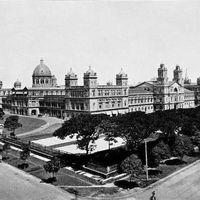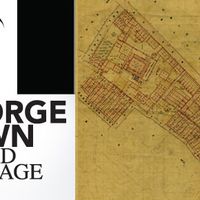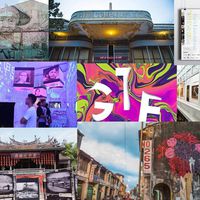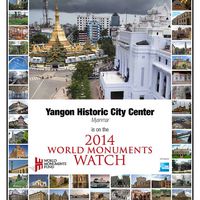Curating culture360.org #4 | Sunitha Janamohanan, George Town World Heritage Inc.

This month of November, culture360.org presents the fourth selection of the series entitled Curating culture360.org. Selected content ‘curators’ review and reflect on the news, articles and opportunities from Asia and Europe they discover on culture360.org. The curators then present a personal content selection, following a theme or narrative driven by their own artistic interests and direction. culture360.org intends to publish Curating culture360.org every two months, inviting artists and cultural commentators from Europe and Asia in turn.
This month Sunitha Janamohanan from the George Town World Heritage Inc. presents a new exciting curatorial journey of culture360.org, looking closely at the field of heritage management in Asia.
The field of heritage management is fraught with challenges, particularly so for developing countries in rapidly urbanizing Asia. Heritage is often not viewed in the context of the cultural or creative industries but merely within the more limited sphere of tourism and the branding of a city or a nation, which can make it a drain or a burden as opposed to an opportunity. Managing heritage can be a struggle within a dichotomy of preservation and progress, and although the two should not be mutually exclusive, it can sometimes feel that way. Working at the George Town World Heritage Inc., an organization that was founded to safeguard the city’s UNESCO World Heritage status, we confront these issues every day. What is crucial to achieving the balance is for governments, local councils, the private sector, NGOs and communities to work together; and as the Manager of Education and Outreach, I am constantly looking for ways to build capacity, learn from others, and facilitate knowledge sharing and discourse.
The articles I have selected here in culture360.org give us a look at some exciting initiatives taking place mainly in Asia, as well as some resources that, I hope, you might find as useful as I have.
1. Two great projects: a corporate-NGO collaboration in Mongolia to save the Choijin Lama Temple complex, and a Public-Private Partnership effort for the revitalization of Gobindgargh Fort in Amritsar, India.
Both are architecturally significant monuments that hold rich historical and intangible cultural significance to their communities, and both projects result in not only a conserved heritage site for tourist consumption, but also much-needed green public space for residents and local use. What underscores both projects is how crucial partnerships are for the effective management of heritage, from funding to legal provisions for the role of communities, and national policies for socially and economically viable frameworks.
Mongolia | Corporate and NGOs partner on heritage conservation
https://culture360.asef.org/magazine/mongolia-corporates-and-ngos-partner-on-heritage-conservation/
India | Built Heritage Management: Gobindgarh Fort, Punjab
https://culture360.asef.org/magazine/india-built-heritage-management-gobindgarh-fort-punjab/
2. Yangon | A City to Rescue
Also very encouraging are the efforts of a rather new NGO in the region, one that we in George Town are looking forward to getting to know, the Yangon Heritage Trust. The YHT is producing a publication by photographers Jacques Maudy and Jimi Casaccia to highlight the need to preserve the beautiful but crumbling colonial architecture of the city.
Yangon | A City to Rescue
https://culture360.asef.org/news/yangon-a-city-to-rescue-photographers-document-architectural-heritage/
3. Chiang Mai Digital Crafts | Bring Crafts to the World
Increasingly, the preservation of cities and their built heritage needs to be done hand in hand with the preservation of traditional lifestyles, crafts and cultural traditions. Communities need to be actively involved, and to survive and thrive, traditions need to continue to be practiced and cultural outputs need to be innovative. A promising initiative in Thailand that integrates creativity, technology and local, traditional knowledge approaches traditional handicraft as a creative industry. It is another great example of public-private collaboration, and, importantly, educational institutional partnership. “Handmade Chiang Mai”brings together research, capacity development and business and economic policy to propel Chiang Mai’s traditional and creative industries forward.
Chiang Mai Digital Crafts | Bring Crafts to the World
https://culture360.asef.org/news/chiang-mai-digital-crafts-bring-crafts-to-the-world/
4. At home and abroad | The Khmer Arts Ensemble
Another example of innovation and tradition working together is the Khmer Arts Ensemble in Cambodia. The Executive Director and co-founder speaks in this interview about developing local audiences, and making a traditional dance form sustainable and appealing to contemporary audiences.
At home and abroad | The Khmer Arts Ensemble
https://culture360.asef.org/magazine/at-home-and-abroad-the-khmer-arts-ensemble/
5. World Cities Culture Report 2012
The recent World Cities Culture Report 2012 focuses on the importance of culture in 12 global cities. The indicators they employ and resulting data are revealing: cultural infrastructure and outputs – from the number of museums, libraries and theatres to books loaned from the libraries per year and per capita, performances and attendance figures, as well as educational statistics in the cultural fields, number of heritage sites, and, of course, tourist numbers. A useful frame of reference for cities with global aspirations.
World Cities Culture Report 2012
https://culture360.asef.org/news/world-cities-culture-report-2012published/
6. Facilitating Arts and Cultural policy dialogue between Asia and Europe
culture360.org offers a number of valuable policy-related resources. Earlier this year, ASEF ran its policy dialogue initiatives. Look at the link at the end of the article for the publication Mapping Cultural Diversity-Good Practices from around the Globe. It’s from 2010, but provides some really good and relevant examples of projects on the preservation of culture and intangible heritage from around the world.
Facilitating Arts and Cultural policy dialogue between Asia and Europe
https://culture360.asef.org/asef-news/facilitating-arts-and-cultural-policy-dialogue-between-asia-and-europe/
7. France | Odyssée 2013 residencies in historic monument cultural centres
To round things off, an interesting opportunity. Most of the residencies available around the world tend to be in the realm of contemporary art creation. The Association des Centres culturels de rencontre (ACCR) in France, however, offers support to member countries in Europe and runs projects like the Odyssée artist-in-residency programme where artists are placed in a cultural centre-historic monument, with the aim to stimulate creative responses to history, raising the profiles of these sites, and encouraging new ways of placing heritage in the popular landscape. The application deadline is December 3.
France | Odyssée 2013 residencies in historic monument cultural centres
https://culture360.asef.org/opportunity/france-odyssee-2013-residencies-in-historic-monument-cultural-centres/
8. NODEM 2012 Hong Kong
This is a conference in Hong Kong, that is not on the culture360.org website but is worth taking a look at, and if possible and you’re in the region, to attend. From Dec 3-5, the symposium NODEM 2012 Hong Kong is bringing together leading theorists, practitioners and artists in conversation about the future of digital heritage, creative practices, design and emerging technologies.
http://www.nodem.org/conferences/hong-kong-2012/
Prepared by Sunitha Janamohanan, George Town World Heritage Inc (www.gtwhi.com.my)
Sunitha Janamohanan has worked as a curator, arts manager and cultural programmer since 1999. She is currently Manager of Education & Outreach for George Town World Heritage Inc. (GTWHI), organizing public education programmes, research projects and capacity building activities in Penang, Malaysia. GTWHI is an agency set up to manage, monitor and promote the historic city of George Town, jointly inscribed with Melaka as a UNESCO World Heritage Site in 2008.
Some links related to GTWHI and George Town:
http://georgetownfestival.com/
http://visionsofpenang.com.my/index.php
Similar content
12 Jun 2013
09 Jan 2012
deadline
31 Mar 2012
30 Nov 2015 - 02 Dec 2015
posted on
15 Oct 2013






